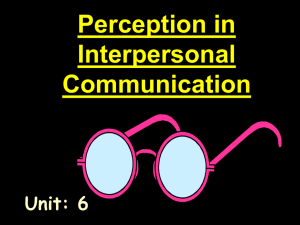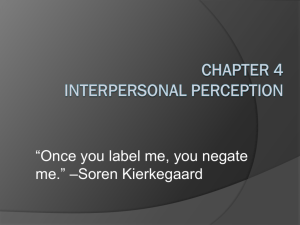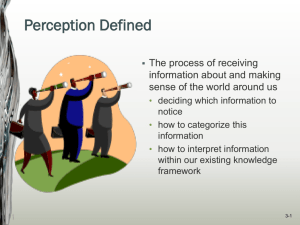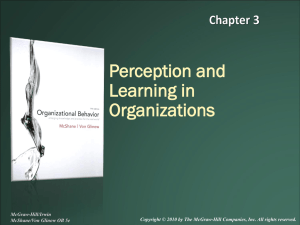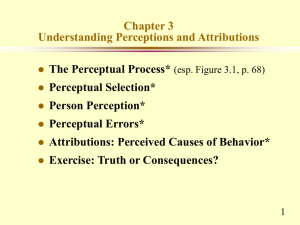File - MAJU SUPPORT
advertisement
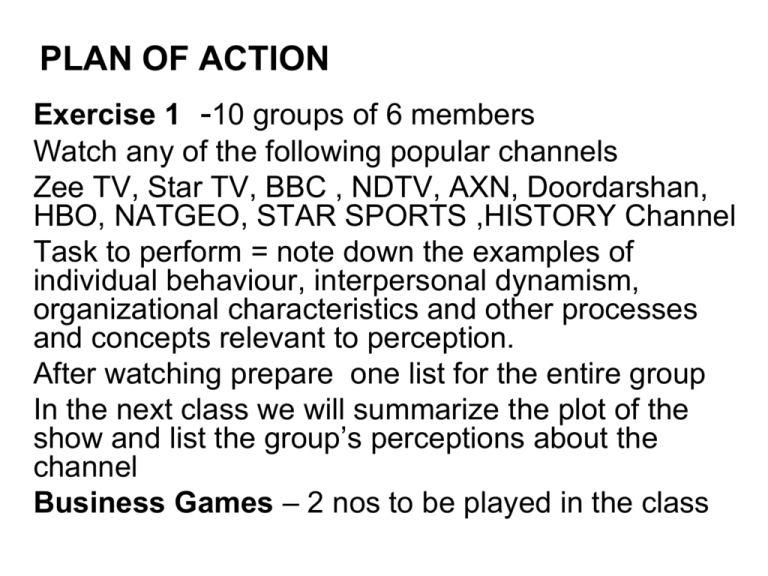
PLAN OF ACTION Exercise 1 -10 groups of 6 members Watch any of the following popular channels Zee TV, Star TV, BBC , NDTV, AXN, Doordarshan, HBO, NATGEO, STAR SPORTS ,HISTORY Channel Task to perform = note down the examples of individual behaviour, interpersonal dynamism, organizational characteristics and other processes and concepts relevant to perception. After watching prepare one list for the entire group In the next class we will summarize the plot of the show and list the group’s perceptions about the channel Business Games – 2 nos to be played in the class What Is Perception, and Why Is It Important? • People’s behavior is based on their perception of what reality is, not on reality itself. • The world as it is perceived is the world that is behaviorally important. Factors that affect perception • The perceiver • The target • The situation • E.g. – A 22 year old man in the late night working as a cab driver and attending the morning management class. PERCEPTUAL PROCESS RECEIVING STIMULI INTERNAL – Learning, vision, smell, touch tastes & EXTERNAL – Light waves, sound waves SELECTING STIMULI EXTERNAL Nature Location Size Contrast Movement Repetition Novelty & Familiarity INTERNAL Learning Needs Age Interests Ambivalence Paranoid Organizing – sensory organs tasting, smelling, hearing and touching Ambiguous figures, Figure Ground, Grouping , Constancy Responses Covert overt Interpreting Attitudes Behavior Stereotyping, Halo Effect Attribution Perceptual Set Motivation Feeling Perceptual Filters We notice • • • • • • • • Rather than Large Bright Loud Strong Unfamiliar Stand out from background Moving Repeated E.g A supervisor scolding /shouting an employee E.g A satyanarayan pooja in the society. small dull quiet weak familiar blend in with background stationary on –off Perceptual Organization • A process by which people group stimuli into recognizable patterns 1) Ambiguous Figures – PO becomes a difficult task when there are confusing and disorganized stimuli in the environment Perceptual Organization 2) Figure Ground – Perceived objects stands out as a separable from their general background Egconversation in a noisy crowd. 3) Perceptual Grouping – Defined by Gestalt psychologist Principle of Similarity – objects have the same shape, size and color Principle of Proximity – to perceive stimuli which are near to another Principle of Closure- the perceivers ability to perceive a whole object even though only part of the object is evident Principle of Continuity - a person will tend to see continuous lines or patterns Figure Ground Principle Process of Interpreting • • Perceptual set- Previously held belief’s about objects influence an individual’s perception Attribution – refers to the process by which the individual assigns causes to the behaviour which he or she conceives • Halo Effect – the tendency of perceiving people in terms of good and bad and ascribing all good qualities to one who is liked and all bad qualities to one who is not liked • Stereotyping – to assign attributes to someone solely on the basis of a category of people to which that person belongs Process of Interpreting • Perceptual Context - the context in which the object is placed • Perceptual Defense – individual is likely to put up the defense when confronted with conflicting , unacceptable or threatening stimuli • Projection – people tend to see other person’s traits that they possess Process of Checking Attribution Theory – Fritz Heider HH Kelly Distinctiveness: To which a person behaves similarly in different situations. Consensus: the degree to which other people are engaging in the same behaviour Consistency: the degree to which a person engages in the same behaviour at different times. EG - A student who gives test. Attribution Theory Fundamental attribution error • “The tendency to underestimate the influence of external factors and overestimate the influence of internal factors when making judgments about the behavior of other.” • Eg- Shop floor supervisor who attributes a high injury rate to employee carelessness instead of considering the machine old and in poor condition Errors Biases in Attribution Theory Self – serving bias • “ The tendency for individuals to attribute their own successes to internal factors while putting the blame for failures on external factors.” When Perception Fails • Self Fulfilling prophecy The story of Pygmalion sculptor People’s expectations or beliefs determine their behaviour and performance thus serving to make their expectations come true Illusions – Incorrect Perceptions 1. those due to physical processes- distortion of physical conditions include mirages, in which an individual perceives objects which are non existent for eg.- an oasis 2. those due to cognitive process • Poggendorf Illusion – In this a line disappears at an angle behind a solid figure, reappearing the other side at what seems to be the incorrect position. Implications for managers • • • • • • Communication Judgment of other people Recruitment and Selection Discrimination Performance Appraisals Impression Management Specific Applications in Organizations • Employment Interview – Perceptual biases affect the accuracy of interviewers’ judgments of applicants. • Performance Expectations – Self-fulfilling prophecy (pygmalion effect): The lower or higher performance of employees reflects preconceived leader expectations about employee capabilities. • Performance Evaluations – Appraisals are subjective perceptions of performance. • Employee Effort – Assessment of individual effort is a subjective judgment subject to perceptual distortion and bias. Managing Perceptions • • • • • • Collect Information Take Time – avoid snap judgments Develop self awareness Check attributions ( obtain feedback) Diversity Management Know yourself
